A Comprehensive Guide to Mastering Kitesurfing Techniques
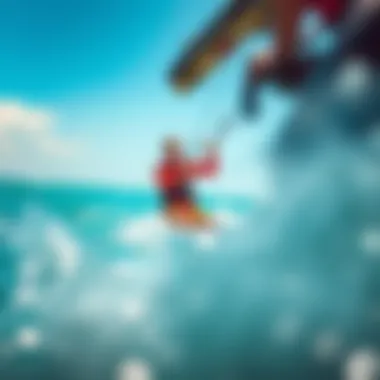
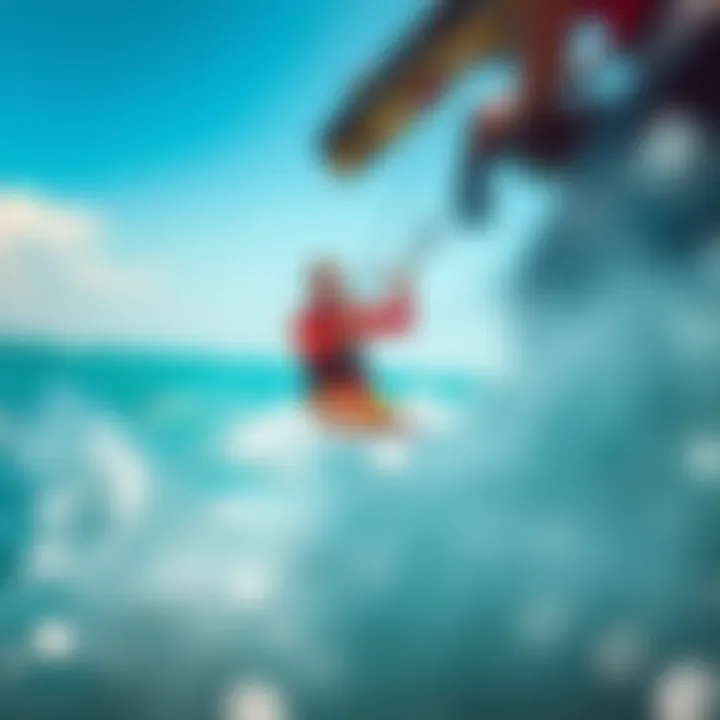
Intro
Kitesurfing, a thrilling blend of surfing, windboarding, and kite flying, has grown in popularity among adventure enthusiasts. With its mix of adrenaline and serenity, it offers a unique experience that appeals to both thrill-seekers and those wanting a peaceful day on the water. But before diving headfirst into the waves, it's imperative to lay a solid foundation of understanding the essentials.
Whether you're fresh off your couch or a seasoned water sports lover looking to add another string to your bow, this guide is tailored for you. By navigating through this article, you'll not only uncover crucial insights into the gear and techniques required but also gain knowledge on safety practices, training, and some of the best global kitesurfing spots.
As with any sport, the right preparation can make all the difference, so buckle up. After all, getting to grips with kitesurfing involves more than just attaching a board to your feet and catching a breeze. Understanding your equipment, respecting safety measures, and honing your skills will pave the way for an exhilarating journey ahead.
Let’s embark on this adventure with an exploration of the first essential aspect of kitesurfing—gear and equipment.
Understanding Kitesurfing Fundamentals
Understanding the essence of kitesurfing is akin to knowing the ropes before climbing a mountain. It lays the foundation on which new enthusiasts can build their skills, fostering a safe and enjoyable environment on the water. Grasping the fundamentals is essential not just for safety but also for maximizing the thrill that this exhilarating sport provides. Anyone stepping onto the water armed with knowledge is a step ahead, making learning smoother and less intimidating. Essentially, this section aims to demystify the key concepts that lay at the heart of kitesurfing.
Defining Kitesurfing
Kitesurfing, often referred to as kiteboarding, combines elements of wakeboarding, windsurfing, surfing, and paragliding. The activity involves riding a board while being propelled across the water by a power kite. This kite harnesses the wind, translating its energy into speed and maneuverability. Picture a finely-tuned dance between the board, the wind, and the sea—where all parts must synchronize flawlessly for an enjoyable ride.
So why should one care about this definition? Well, it sets the stage for everything you will do. Knowing what kitesurfing is makes clear the intricacies involved, from choosing the right gear to mastering the technical skills necessary to glide gracefully through waves. The beauty of this sport lies in its synergy; the rider, the board, and the kite all interact to create a unique experience.
The Mechanics of Kite Control
Understanding how to control your kite is crucial—it’s the difference between a graceful ride and a daunting tumble. Kite control involves steering and managing the kite’s power effectively. It’s not just point-and-shoot; it requires a delicate balance, akin to conducting an orchestra where the kite serves as the lead instrument.
- Sheeting In and Out: This term refers to adjusting the amount of power you are drawing from the kite. Pulling the control bar towards you (sheeting in) increases power, while pushing it away (sheeting out) decreases it. Learning when to use each technique is essential; timing is everything in kitesurfing.
- Body Position: Your posture affects how well you control the kite. Keeping your body low and balanced helps in maintaining control, especially during turns and jumps.
- Wind Variations: Understanding how different wind patterns influence kite performance is vital. The wind isn’t always consistent; it shifts and changes, requiring quick adjustments.
"The wind is your silent partner; if you listen carefully, it will guide you through the waters."
When you master the mechanics of kite control, embarking on your kitesurfing journey becomes a significantly more enjoyable affair. Getting through early learning phases may look challenging, but with each small step, it enhances your ability to harness the wind's power effectively and safely, leading to more exhilarating rides on the water.
Ultimately, understanding the fundamentals of kitesurfing serves as the building blocks for enthusiasts to progress. If you're keen on honing your skills, be ready to embrace the learning experiences that come with it. Stick with it, and soon you'll find yourself navigating waters with the same ease as a fish swims in its pond.
Essential Gear for Kitesurfing
When diving into the world of kitesurfing, understanding the right gear can mean the difference between an enjoyable experience and an arduous struggle. The essential gear for kitesurfing serves a vital role, not only enhancing your performance but also ensuring your safety while you’re riding the waves. The right kite, board, and additional equipment are fundamental to elevating your skills and comfort on the water. Let’s peel back the layers and look closely at the vital components that comprise kitesurfing gear.
Choosing the Right Kite
Size Considerations
Selecting the right kite size is crucial for various factors, such as wind conditions, your weight, and skill level. Generally, larger kites are ideal for lighter winds, offering greater lift, while smaller kites excel in stronger winds, providing more control. This balance is essential.
A 9 or 10-meter kite works wonders for most conditions experienced by beginners, as it is versatile enough to handle light breezes while still having the power for better winds. However, if you're on the lighter side, a larger kite might suit you better when the wind is calm.
Keep in mind, the choice of kite size directly influences how much power the kite generates, impacting your speed and stability on the board.
Types of Kites
There are primarily three types of kites, each serving a unique purpose: inflatable kites, foil kites, and hybrid kites, which blend features from both. Inflatable kites, like the Cabrinha Switchblade, deliver solid performance across various conditions, making them a popular pick among novices and seasoned riders alike.
Foil kites, while offering an efficient power-to-weight ratio, require a finesse that many beginners may not yet possess. They are suitable for light winds and have a more consistent pull compared to inflatables. Hybrid kites, on the other hand, provide versatility and can adapt to different conditions, which can be a great all-rounder for those still figuring out their style.
Selecting a Board
Types of Boards


The type of board you opt for can significantly influence your performance. Common types include twin-tip boards, directional boards, and freestyle boards. Twin-tip boards are widely used because they are symmetrical, allowing for easy riding in either direction, which is particularly beneficial for beginners.
Directional boards are geared toward those who embrace wave riding. They’re ideal for surfers who want to catch the swell and perform cuts dynamically. Freestyle boards, designed with tricks in mind, feature a stiffer build, which enables better pop off the water but can require more skill to ride effectively.
Board Sizes
When it comes to board sizes, the length and width directly impact performance. Longer boards tend to glide better across the surface, resulting in a smoother ride, while shorter boards are typically more maneuverable. Generally, a wider board provides buoyancy, helping you to stay afloat during lighter winds.
Another aspect to consider is your weight. Heavier riders might prefer larger boards to ensure they can ride efficiently without sinking too deep into the water, whereas lighter individuals should lean towards smaller boards for easier control.
Other Necessary Equipment
Harnesses
A harness is a must-have item since it connects your body to the kite. Finding the right fit is paramount. There are waist and seat harnesses available, with seat harnesses being more comfortable for beginners. They distribute the load more evenly across your hips, giving you more stability while riding.
The unique feature of a good harness is its ability to allow for maximum freedom of movement while providing the necessary support, so you can focus on mastering your skills.
Safety Leashes
Safety leashes act as a life-line. It attaches you to the kite, ensuring that even in the event of a wipeout, you won’t lose control of your kite. Selecting a sturdy leash is critical because a proper leash can withstand significant strain to avoid snapping in gusty winds. A reliable leash design also features quick-release mechanisms for emergencies, helping you detach quickly if necessary.
Wetsuits
Depending on your location, a wetsuit may be essential to keep you warm and protected from the elements. A good wetsuit is tailored to the water temperature; thicker suits are beneficial for colder climates to maintain your body heat. They offer more than insulation; they also protect against sunburn and minor scrapes. The flexibility that a wetsuit provides is another factor to consider, as it should allow you to swim reasonably well while keeping you snug.
Safety Practices in Kitesurfing
Safety should never take a backseat when you’re out on the water, and kitesurfing is no exception. Understanding the risks and knowing proper safety practices can make the difference between an exhilarating experience and one that ends in mishaps. In this segment, we’ll break down crucial safety protocols that can significantly enhance your kitesurfing adventures, ensuring you can focus on the joy of the ride rather than worry about hazards.
Understanding Wind Conditions
Wind is a vital component in kitesurfing, as it provides the power that propels you across the water. Knowing how to interpret various wind conditions can mean the difference between a good day on the water and an unsafe one.
Key Points to Consider:
- Wind Strength: This is typically measured in knots. For beginners, it’s advisable to ride in winds of 10-20 knots. Winds over 25 knots can quickly become overwhelming.
- Wind Direction: Understanding which way the wind is blowing is crucial. Cross-shore winds are ideal, whereas onshore winds can create challenges, including difficult landing situations.
- Wind Consistency: If the wind is shifty or gusty, it can impact your control over the kite. Always be on the lookout for sudden changes in wind patterns.
Many a seasoned kitesurfer has found themselves in tricky waters simply by not checking wind conditions before heading out.
Safety Gear Essentials
Equipping yourself with the right safety gear is imperative in kitesurfing. Let’s take a closer look at two must-have items:
Helmets
One could argue that a helmet is a kitesurfer's best friend. When you’re flying off jumps or getting tossed around by the ocean, a decent helmet can provide that extra layer of protection your noggin needs.
- Key Characteristic: A well-fitted helmet often includes a visor to shield your eyes from the sun or water spray, ensuring that vision remains optimal while you navigate the waves.
- Benefits: Helmets made specifically for water sports are lightweight yet durable, which allows for a greater sense of security without much bulk.
- Consideration: While a helmet protects against head injuries, it may not be as effective in preventing minor bumps and scrapes during the learning phase. Always ensure it fits snugly for maximum safety during your kitesurfing sessions.
"Wearing a helmet off the water makes about as much sense as fishing without a hook."
Impact Vests
When hitting the water hard, impact vests can provide much-needed protection for your ribs and torso. For both beginners and seasoned surfers, it's an essential piece of kit.
- Key Characteristic: Many impact vests are designed with extra padding specifically around sensitive areas to absorb shock upon impact effectively.
- Benefits: They allow freedom of movement while minimizing the risk of injury when you take a tumble.
- Consideration: While they do provide great protection, some may feel hindered in terms of buoyancy. It's important to find a balance between comfort and protection.
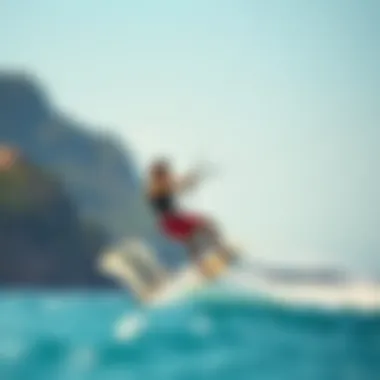
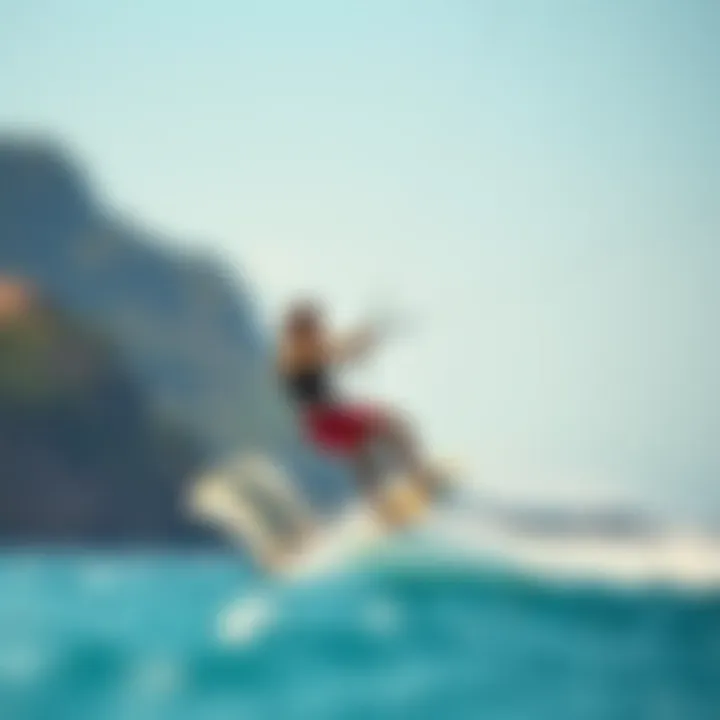
Overall, being aware of wind conditions and properly gearing up can significantly boost your confidence and safety while kitesurfing. Remember, the aim is to embrace the thrill of the sport while minimizing unnecessary risks. As you step out into the waves, a proactive approach to safety will allow you to enjoy every moment on the water.
Mastering Basic Kitesurfing Techniques
Understanding the fundamentals of kitesurfing is a crucial step in elevating your skills on the water. Mastering basic kitesurfing techniques sets the stage for safely enjoying this exhilarating sport. Newcomers often feel overwhelmed by the various elements involved, from controlling the kite to catching waves, but these initial techniques are essential. They not only build confidence but also provide a solid foundation for more advanced maneuvers.
Launching the Kite
Launching the kite is often the first major hurdle for beginners. Getting this right is paramount, as it dictates the entire kitesurfing session. Here are a few key points to consider when launching your kite:
- Choose the Right Spot: Make sure to find a clear area away from obstructions like trees or other people. Safety first, always!
- Ask for Assistance: If you're a novice, having an experienced kiter assist in the launch is invaluable. They can help guide the kite into the correct position.
- Control the Wind: Hold the kite by the leading edge and bring it into the wind window. Ensure you have enough tension on the lines to keep it stable.
Before your first launch, practice the commands and what to look for in your kite. Taking your time here pays off in the long run.
Controlling the Kite
Once the kite is in the air, the next skill to master is controlling it. This is where the magic really begins. Effective kite control involves understanding how the wind interacts with the kite, which also affects your movement on the board.
- Steering Techniques: Use the bar to steer the kite left and right, but make sure to keep your movements fluid. Jerky actions can lead to loss of control.
- Power Management: Pulling on the back lines increases power; releasing them reduces it. Learning to manage this power dynamically is key! Keep practicing to develop a feel for it.
- Adjusting Positioning: While in the air, lean and shift your weight to control the direction of the kite while maintaining a steady speed.
Mastering kite control not only enhances your enjoyment but is essential for progression.
Getting Up on the Board
Now we get to the exciting part: getting up on the board. This technique can be a source of frustration for many learners, but once you get it, the freedom you'll feel is worth every stumble.
- Body Positioning: Start by lying flat on your stomach, with the board parallel to the kite. This positioning helps prevent the board from catching too much wind.
- Timing is Everything: As you feel the kite pulling you, engage your core and lift your body. Don’t rush it - a steady pull and timing with the kite's power is crucial.
- Feet Placement: Get your feet securely in the straps while keeping your knees slightly bent. After gaining stability, begin carving the board.
Getting up on the board is not just about physical strength but rather mastering the balance and movement at the right moment.
With dedication and practice, these basic techniques become second nature. Don’t forget to embrace the challenges each session brings, as they’re all part of the learning curve. This makes ultimate mastery of kitesurfing that much sweeter.
Progressing to Advanced Techniques
Once you’ve managed the basics of kitesurfing, the allure of pushing your skills further becomes irresistible. Progressing to advanced techniques not only enhances your performance but also amplifies the joy and thrill found in the sport. As you advance, your confidence grows, and you may find yourself attempting maneuvers that once seemed daunting. This section outlines the key advanced skills to tackle and their importance in achieving greater mastery over the waves.
Executing Jumps
Jumping is a cornerstone of the kitesurfing experience. It gives riders the ability to catch air and perform aerial tricks that are not only exhilarating but visually spectacular. To execute a jump, it’s key to combine the right amount of speed, kite positioning, and body movement.
When you're ready to take to the air, ensure your kite is positioned at the right angle. A higher kite can help generate lift, while good speed assists in your elevation. As you move into the jump, compress your knees and extend upwards, using the wind and kite power to carry you. The thrill of soaring above the water can provide both a rush and a sense of accomplishment.
Performing Tricks
Rotations
Rotations are among the most sought-after tricks in kitesurfing. They not only add flair to your jumping capabilities but also allow you to express personal style on the water. To perform a rotation, you need to understand the dynamics of your kite and board in the air.
- Key Characteristic: The beauty of rotations lies in their versatility. Whether you opt for a simple 180 or a more complex 540, they can be tailored to your skill level.
- Benefits: Rotations break the monotony, turning your kitesurfing sessions into creative performances.
- Unique Features: You can integrate different grabs or spins into rotations, adding complexity and personal flair to your maneuvers. However, precision is crucial, as improper execution can lead to crashes.
Grabs
Grabs are another exciting aspect of advanced kitesurfing tricks. When you grab your board mid-air, it showcases control and adds style to your jumps.
- Key Characteristic: A grab involves reaching down to hold the board with one hand while in the air, which requires excellent balance and timing.
- Benefits: Grabs are not only visually impressive but also demonstrate skill and stability in the air. They allow riders to personalize their jumps, transforming a standard jump into a signature move.
- Unique Features: Different grabs can be used—like the nose grab or tail grab—highlighting various styles. The challenge is to balance grabbing the board and maintaining flight, which can take time to master.
Mastering jumps, rotations, and grabs will elevate your kitesurfing adventure.
As you dive deeper into these advanced maneuvers, remember the importance of practice and patience. Each jump and trick is part of the kitesurfing journey, helping you develop into a well-rounded kitesurfer. Stay persistent and keep pushing your limits, and you'll find that the journey is as rewarding as the destination.
Kitesurfing Locations Around the World
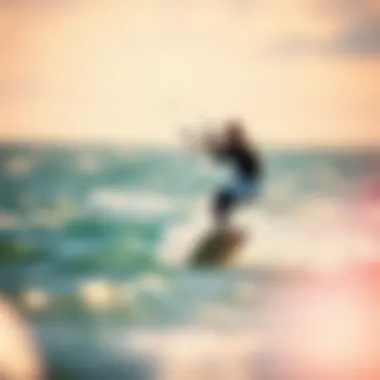
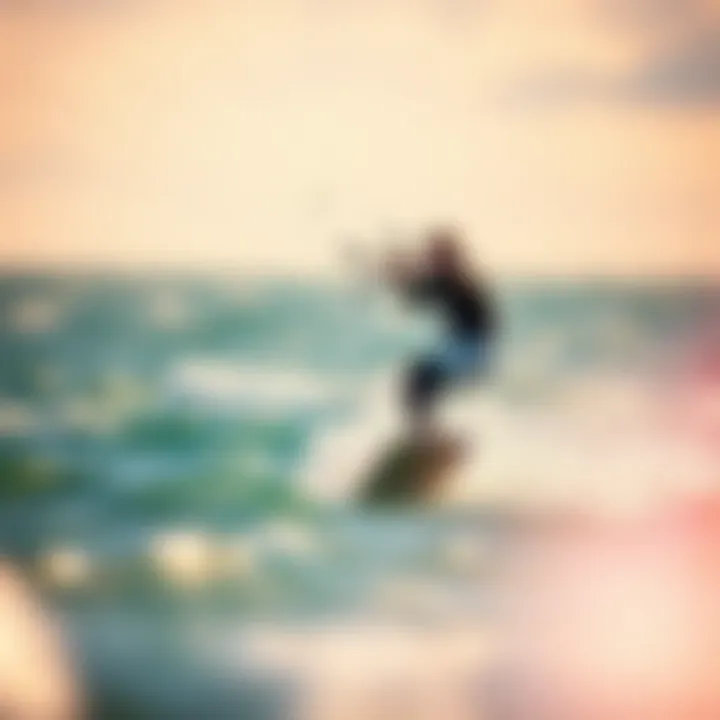
Choosing where to kitesurf plays a crucial role in the overall experience. The right location can ignite a spark of excitement. It turns an ordinary session into a memorable adventure. Not only does it influence skill development, but it also shapes the social aspect of the sport. A good spot must offer favorable wind conditions, suitable waves, and a sense of community. Ultimately, the varied landscapes and climates across the globe offer something unique to every kitesurfer.
Top Beaches in North America
North America boasts some of the most stunning kitesurfing spots, attracting both beginners and pros alike. Here are a few standout beaches:
- Cape Hatteras, North Carolina: Known for its consistent winds and shallow waters, this spot is a haven for kitesurfers. The Hatteras Island provides diverse conditions, making it perfect for everyone, from novices to experienced riders.
- Santa Teresa, Costa Rica: A picturesque beach that combines stunning sunsets with good wind conditions. The relaxed atmosphere is complemented by a vibrant local community.
- Kings Beach, California: Nestled near Lake Tahoe, this beach is great for those who love fresh-water conditions and a breathtaking backdrop.
Popular Spots in Europe
Europe's coastal regions are etched with beautiful beaches ideal for kitesurfing. They range from southerly warm waters to northern wind-swept terrains. Some notable mentions include:
- Tarifa, Spain: Often dubbed the wind capital of Europe, this place features countless days of excellent wind conditions. The mix of a vibrant atmosphere and beautiful scenery attracts many kitesurfers.
- Cumbuco, Brazil: While not strictly in Europe, it's worth mentioning due to its popularity among European kitesurfers. It offers steady trade winds and stunning lagoons.
- Lago di Garda, Italy: Known for its gorgeous lakeside views, this destination provides steady winds, making it an ideal spot for both learning and executing advanced tricks.
Exotic Destinations for Kitesurfing
For those itching to explore kitesurfing away from beaten paths, exotic locations offer once-in-a-lifetime experiences. These might not be the first places that come to mind, but they pack a punch:
- Boracay, Philippines: Renowned for its white sandy beaches and crystal-clear waters, Boracay is a remarkable location that draws kitesurfers from all over the world. The warm weather and stunning landscapes make for an unforgettable session.
- Seychelles: A paradise for kitesurfers, the islands offer a wealth of natural beauty, from rocky cliffs to serene beaches. This exotic location promises both adventure and tranquility.
- Maui, Hawaii: Considered one of the ultimate kitesurfing destinations, Maui features breathtaking scenery and reliable winds. It's ideal for those seeking an exhilarating kitesurfing experience amidst vibrant island life.
"Kitesurfing is more than a sport; it’s a journey into the heart of nature and community, capturing the thrill of the wind and waves."
Embarking on a kitesurfing adventure means no shortage of extraordinary places to discover. With such an array of options, each with their unique environment and community vibe, there’s no excuse not to strap on that harness and hit the water!
The Kitesurfing Community
The kitesurfing community serves as the very backbone of the sport, connecting aficionados with shared passions, experiences, and aspirations. Engaging with others not only enriches one’s learning journey but also fosters a vibrant culture of support and camaraderie. It's essential for any beginner to realize that they are part of something larger, a family united by the thrill of harnessing the wind, and this sense of belonging can significantly enhance one’s enthusiasm and motivation.
Connecting with Fellow Enthusiasts
Finding your tribe in kitesurfing is about more than just exchanging tips; it’s about building friendships and memories. The bonds formed in the salty breeze of the ocean or on the shores can lead to a support system that lasts for years. Whether you’re sharing stories of triumph—like the time you finally nailed that jump—or discussing essential gear upgrades, these interactions pave the way for mutual growth.
- Join Local Clubs: Look for local kitesurfing clubs or schools. They often host events and gatherings where you can meet other kiteboarders. Websites like Facebook and Reddit are invaluable for finding these groups.
- Online Forums: Platforms like Kiteforum provide spaces to ask questions and share experiences with a global network. Here, you can learn from seasoned surfers or novices just like you.
Through these connections, beginners often get insights into conditions, local hot spots, and even mentorship opportunities, which can be extremely beneficial when you're just starting out. It’s in this web of relationships that many kiteboarders discover new techniques, safety practices, and ways to push their skills to the next level.
Participating in Events and Competitions
Events and competitions in the kitesurfing community not only showcase talent but also serve as a fundamental learning ground. They offer a chance to watch, learn, and engage with a host of levels from newcomers to seasoned professionals. Whether competing or merely attending, being part of these gatherings nourishes one's passion for the sport.
- Local Competitions: Often held at popular kitesurfing locations, these competitions encourage participants to step outside their comfort zones. It can feel daunting at first, but the thrill of competition can drastically improve your skills.
- Workshops and Clinics: Many events include workshops that cover various techniques, gear demonstrations, and safety seminars. For instance, the annual ‘Kitesurfing Festival’ in Costa Rica includes masterclasses that help participants refine their skills while also providing a social platform to connect with fellow kite surfers.
"Events are where the magic happens—where friendships are forged, and lifelong memories are made."
Being part of the kitesurfing scene means embracing opportunities for competition and camaraderie alike. Whether you choose to watch from the sidelines, participate, or volunteer, these experiences will deepen your understanding of the sport and expand your horizon.
Ending: Embracing the Kitesurfing Journey
The path of kitesurfing is not merely a sport; it's an intricate dance between wind, water, and rider. This article encapsulated various facets of kitesurfing, from understanding its core mechanics to diving into the nitty-gritty of gear and safety practices. As participants in this exhilarating activity, one has to truly embrace the journey, recognizing its challenges and rewards. Kitesurfing is as much about personal growth and discovery as it is about riding the waves.
Setting Goals for Improvement
When one embarks on the adventure of kitesurfing, the horizon is filled with potential. Setting realistic goals can help navigate this vast sea of possibilities. Here are several aspects to consider:
- Skill Development: Whether aiming to master basic maneuvers or attempting complex tricks, defining clear milestones can keep progression on track.
- Physical Conditioning: Kitesurfing demands physical strength and endurance. Establishing fitness goals can contribute significantly to performance in the water.
- Learning Environment: Choose diverse locations for practice. Different wind conditions and water types challenge riders in unique ways, fostering improvement.
- Community Engagement: Interacting with fellow kitesurfers can provide new perspectives and tips, thus setting goals around attending events or meetups can also be beneficial.
Continuing the Adventure
The journey doesn't merely end with mastering the essentials. Kitesurfing opens doors to countless experiences and adventures that go beyond the basics:
- Exploring New Locations: There are beaches all over the world beckoning kitesurfers to explore. Plan trips to renowned kitesurfing destinations like Tarifa in Spain or the flat waters of Flathead Lake in Montana.
- Participating in Competitions: Engaging in local or international competitions can provide motivation and the thrill of testing skills against others.
- Evolving Techniques: As one gains confidence, tackling new techniques can keep the sport fresh and exciting. Whether it’s learning to jump higher, or master spin tricks, there's always something new to learn.
- Advocacy for Sustainable Kitesurfing: As kitesurfing continues to grow, it’s vital to promote practices that protect our oceans and beaches. Engaging in community clean-ups or advocating for sustainable tourism can be fulfilling aspects of the sport.
With the right mindset and a commitment to ongoing improvement, kitesurfing can become not just a seasonal thrill but a lifelong passion. In every gust of wind and splash of water, riders can find both solace and exhilaration, creating a truly immersive experience that connects them to nature and to each other.



